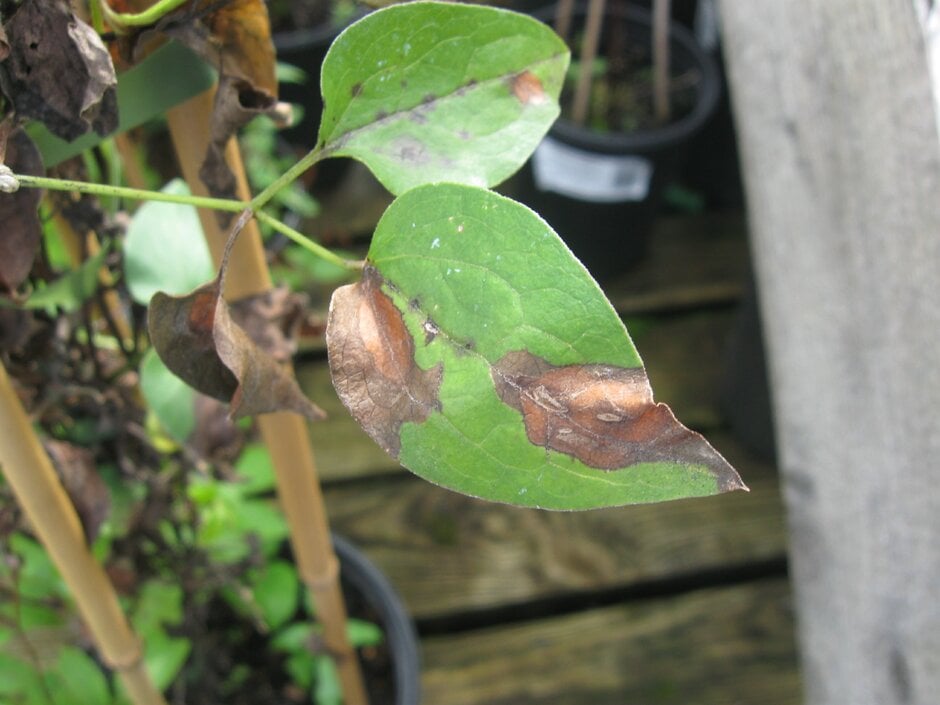Clematis wilt
Clematis wilt is a fungal disease of clematis, particularly the large-flowered hybrid cultivars. The fungus causes rapid wilting and, in severe cases, can kill the whole plant.

Quick facts
Scientific name Calophoma clematidina (syn. Phoma clematidina, Ascochyta clematidina)
Plants affected Some Clematis cultivars
Main symptoms Rapid wilting and death
Caused by Fungus
What is clematis wilt?
Clematis wilt is a disease of clematis caused by the fungus Calophoma clematidina (syn Phoma clematidina, Ascochyta clematidina). Several of the large-flowered
Wilting has long been recognised as a serious problem in clematis. Although it is known that Calophoma clematidina causes clematis wilt, there are many cases of wilting symptoms in clematis recorded where the fungus is not present. Research has clarified two important points:
- Wilting in large-flowered hybrid cultivars may be caused by Calophoma clematidina, in which case it should be possible to find some of the symptoms described below
- Wilting in resistant hybrids and species clematis is very unlikely to be C. clematidina, and is probably caused by cultural problems, other diseases, or feeding damage from invertebrates. These other problems are equally common on the large-flowered hybrids
So, although wilting in clematis plants is often blamed on C. clematidina, unless it affects one of the more susceptible large-flowered hybrids it is most likely to be caused by something else. On any clematis, wilting of shoots is often the result of problems such as grazing of the stems by invertebrates (e.g. slugs and snails) or simply physical damage (such as twisting of stems in strong winds). Both hybrid and species clematis can also be affected by root diseases such as Phytophthora root rot and honey fungus, and because the root system is unable to function properly wilting will result.
Clematis is a plant which, in the natural environment, prefers a deep and fertile soil in a moist and shaded habitat. However, in gardens, clematis are often planted in shallow dry soils in exposed sites, often close to buildings. In such circumstances they suffer from severe stress which contributes to poor growth and what is loosely described as wilt. Overall, infection by C. clematidina is an occasional problem for the nursery trade and specialist growers, but relatively uncommon in gardens.
Symptoms
The symptoms of fungal infection and environmental stress can be similar. The following symptoms are associated with infection by C. clematidina:
- Infection can occur through the leaves, causing leaf spots. Affected leaves may then shrivel and the leaf stalks turn black. Leaf infection is followed by wilting of the stems
- Infection can also occur directly through stems. Freshly affected stems show black discolouration of tissue when split open
- Young healthy shoots may be produced from the base of affected stems, sometimes from below ground
Control
Non-chemical control
- Try to create a suitable root environment by deep cultivation and mulching, to minimise root stress
- If clematis wilt infection is suspected, cut out all wilted stems back to healthy (non-stained) tissue and promptly destroy the affected material to prevent it contaminating the soil. New healthy shoots may be formed at ground level
- Disinfect pruning tools to prevent contamination, and avoid transferring infected plant and soil material to a new area
- Particularly susceptible cultivars include: Clematis ‘Henryi’, ‘Vyvyan Pennell’, ‘Mrs N. Thompson’, ‘Duchess of Edinburgh’, ‘William Kennett’, ‘Marie Boisselot/Madame le Coultre’, ‘Ernest Markham’. Clematis 'Comtesse de Bouchaud'; C. 'Jackmanii' and C. 'Nelly Moser' are also susceptible
- Resistant cultivars and species include: Clematis ‘Avant Garde’, ‘Bonanza’, ‘Confetti’, C. alpina, C. montana, C. orientalis, C. viticella (which is tolerant rather than resistant), C. integrifolia, C. macropetala, C. tangutica
Chemical control
There are no chemicals available to treat clematis wilt.
Biology
Calophoma clematidina can survive in the soil on dead plant material and organic matter. Infection occurs when spores are splashed or otherwise carried to leaves or young stems. Infection spreads to the shoots and stems (which, when split open, are stained black inside) and causes rapid wilting and death. The root system is often not killed and young shoots frequently regenerate from or below ground level. The disease is not immediately fatal, but infected susceptible cultivars will usually die eventually.
Get involved
The Royal Horticultural Society is the UK’s leading gardening charity. We aim to enrich everyone’s life through plants, and make the UK a greener and more beautiful place.